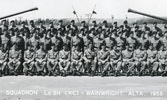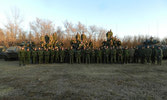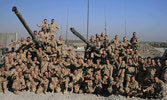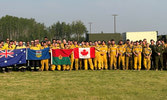Tank Centralization: D Squadron Becomes C Squadron
By: Major Bryce Simpson, OC D Sqn and WO Derek Murdoch, SSM D Sqn
In 1956, the Canadian Army recognized that not maintaining formation reconnaissance elements in the Regular Force was a major deficiency in its force structure. Consequently, the Regular Force regiments of the day were allotted a fourth subunit to fill the Brigade Reconnaissance role, and D (Recce) Squadron, Lord Strathcona’s Horse (Royal Canadians) was born shortly thereafter. In a reflection of the operational demand which this squadron would constantly exist under, Recce Squadron served immediately in Canada’s NATO brigade in Germany until 1959.
From this auspicious foundation, D Squadron built for itself an enviable reputation as versatile reconnaissance-specialists both at home and abroad, serving as a formed body on a multitude of international operations including Egypt, Cyprus and the former Yugoslavia. Recce Squadron was the first armoured subunit in the Canadian Army deployed to Afghanistan in 2002, beginning the Regiment’s long commitment to that conflict. The squadron has also been employed on an increasing number of domestic operations including its final act of operational service during the Canadian Army’s recent response to the Alberta Wildfires in June 2023.
Over the years, D Squadron undoubtedly took on a ‘distinct’ character within Regimental lines. Occasional cycles of ghillie-suit wearing, knife throwing, and a general disdain for vehicle maintenance (beyond kicking Coyote tires) typified the squadron approach to their role. High levels of warrior spirit often found expression in impromptu ‘close quarter combat’ bouts between Recce soldiers with only occasional resulting injuries during uncounted smokers and BBQs. Friendly rivalry with the Regiment’s tank-mounted squadrons only rarely escalated to the level of civil strife (the unfortunate destruction of Fort Recce in Wainwright by an errant Leopard notwithstanding). The squadron’s characteristic enthusiasm for its special place in the brigade, indisputably sustained its morale through innumerable field deployments and operations.
The last few years have seen the squadron undergo significant transformation. Notably, the ‘Cavalry Concept’ saw D Squadron drop the ‘Reconnaissance’ title and adjust its force structure to adhere to the new doctrinal proposals while striving to retain the inherent flexibility and reconnaissance/security capability provided by a light armoured fighting vehicle equipped subunit. Now, with the Canadian Army centralizing the Leopard 2 family of vehicles in Alberta, D Squadron is to be transformed into a tank squadron, a process which has already begun with the qualification of 20 new Leopard drivers within the squadron in June.
On 29 June 2023, during the Change of Command / Change of Appointments parade held that day, D Squadron officially turned in its pennant to outgoing CO, Lieutenant-Colonel M.J.D. Mallette (a Recce alumnus) and received the C Squadron pennant, reviving a squadron with its own long history that had removed from the Regimental order of battle in 2012.
The Regiment’s new C Squadron has a proud history of its own to look back upon. Formed primarily of personnel recruited from British Columbia, C Squadron stood up in 1900 with the original Strathcona’s Horse to fight in South Africa. It was stood down until 1914, re-raised for the Great War, and was the squadron of Lieutenant Flowerdew, VC which charged at Moreuil Wood. It was stood down again after that conflict only to be revived again for the 1939-1945 war, serving with the Regiment in Italy and Northwest Europe. Placed in suspended animation a third time, it was reestablished in 1951 as the Army expanded for the Cold War and Korea. C Squadron served in the various peacekeeping missions of the Cold War period, before two tours in Afghanistan as a tank squadron. Following the conclusion of Canada’s participation in this conflict, it was stood down once more in 2012. As a 1951 Strathcona newsletter indicates: “thus, in the past, C Squadron has been called back into harness only when there was a job to be done in war. Our present revival may well be a sign of the times.” With the Regiment’s operational commitment to Latvia growing, and the geopolitical situation becoming increasingly tense, perhaps these words will prove prophetic for C Squadron?
As for D (Recce) Squadron, the title and customs of this unique subunit will reluctantly go into retirement, with the Canadian Army’s light armour and reconnaissance capabilities being concentrated within the other two Regular Force Regiments. But as the many officers and soldiers who have served in D Squadron know, the situation in the Army – much like the life of a recce squadron in the field – is defined by change, chaos, and sometimes by fate. Future Strathconas will always remain ready to bring D Squadron’s pennant back out on parade – and it may well be seen ‘out front’ of the Regiment in the field once again!





